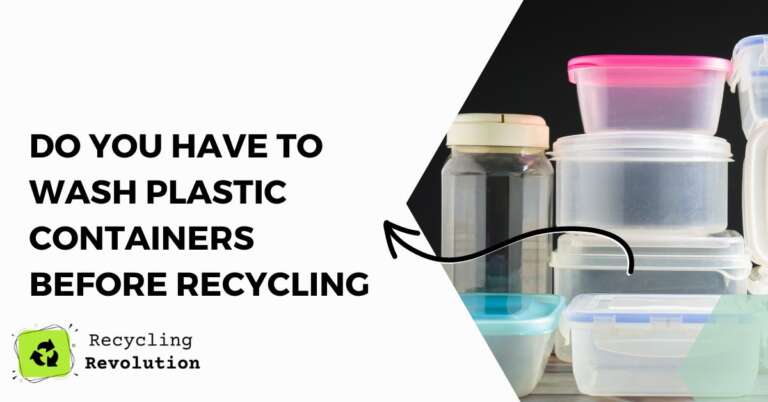Recycling has become an integral part of our everyday lives as we strive to decrease our environmental footprint. One common question we encounter is, “Do you have to wash plastic containers before recycling?”
The short answer is: Yes, it is crucial to rinse or wash your plastic containers before recycling them. This step not only enhances the quality of the recyclables but also maintains the efficiency and safety of the recycling process.
TL;DR: Thoroughly rinse or wash your plastic containers before recycling. This action aids the recycling process, reducing contamination and ensuring better-quality recycled products.
🧴 Plastic Recycling Estimator
🔍 Plastic Buyback Facts
Most buyback programs accept PET (water bottles), HDPE (detergent containers), and PP (caps, cups). Light plastics like bags and wrappers are harder to recycle, but containers and jugs are highly valued. Recycling plastic reduces landfill overflow and saves fossil fuels.
Why Should You Clean Plastic Containers Before Recycling?
When it comes to recycling, contamination is a significant issue. Contamination refers to non-recyclable materials or residual waste present in the recyclable items, and it’s something that recycling facilities grapple with daily.
Here’s why washing your plastic containers before recycling is a key solution to this problem:
Maintaining the Quality of Recyclables
Plastic containers often house food products or beverages. When residues of these materials remain, they can soil other items during the recycling process. Over time, this can lower the overall quality of the recycled products produced.
I recommend always ensuring that your plastic containers are empty and clean before tossing them in the recycling bin.
Preventing the Spread of Bacteria and Pests
Food residues in plastic containers can lead to bacterial growth and attract pests, both in your home and at the recycling facility. By washing your plastic containers, you’re aiding in maintaining a hygienic environment and ensuring the health and safety of the workers at the facility.
Enhancing the Efficiency of the Recycling Process
Recycling plants often have to spend time and resources sorting out contaminated items. If plastic containers arrive clean, it eases the process and allows for more efficient recycling.
How to Clean Plastic Containers Before Recycling: A Step-by-Step Guide
Now that you understand why it’s essential to clean your plastic containers before recycling, let’s look at how you can do it:
- Empty the container: Ensure that you’ve removed all the contents of the container.
- Rinse with warm water: Use a small amount of warm water to rinse the container. This step usually helps remove most residues.
- Use a tiny bit of dish soap: If the container is still dirty, use a drop or two of dish soap to help remove stubborn stains or residues.
- Air dry: Allow the container to air dry before placing it in your recycling bin.
Note: If a container is excessively soiled and cannot be adequately cleaned, it might be best to dispose of it in the regular trash.
The Environmental Impact of Cleaning Plastic Containers
There’s an environmental impact associated with cleaning plastic containers before recycling as you’re using water and sometimes detergents to ensure these containers are fit for recycling.
However, the benefits generally outweigh the downsides. Contaminated recyclables can cause entire loads to be sent to the landfill, which is an outcome we desperately need to avoid.
Still, to mitigate these impacts, I recommend using wastewater where possible for cleaning. This could be water left over from washing dishes or vegetables. It’s a small step but when compounded over millions of households, it can result in significant water savings.
Types of Plastic Containers and Their Recycling Guidelines
Understanding the types of plastic containers in your home and how to recycle them properly is crucial. It’s not just about rinsing them out; different types of plastic require different handling:
- PET (Polyethylene Terephthalate): Often used in soft drink bottles, cooking oil bottles, and many common food packages. They are typically easy to clean and widely recycled.
- HDPE (High-Density Polyethylene): Commonly used in milk jugs, detergent bottles, and juice bottles. These are also widely recycled and easy to clean, but remember to remove the caps and rinse thoroughly.
- PVC (Polyvinyl Chloride): You might find PVC in cling wrap, some types of food packaging, and bottles. PVC is not usually recycled and can release toxins when incinerated.
- LDPE (Low-Density Polyethylene): Commonly found in grocery bags and plastic wrap. LDPE is recyclable, but not often accepted in curbside programs. Clean it thoroughly to avoid contamination.
- PP (Polypropylene): Common in yogurt containers and syrup bottles. These need to be clean and dry before being put in your recycling bin.
- PS (Polystyrene or “Styrofoam”): Found in takeout containers and cups, PS is not commonly accepted for recycling due to its lightweight and low scrap value.
This quick guide should help you recognize the different types of plastic in your home and their respective recycling guidelines. Always remember to check with your local recycling program for specific instructions.
Don’t Forget to Reduce and Reuse
While recycling is a crucial part of managing our waste, it’s not the only solution. As part of our responsible consumption habits, we should also focus on reducing and reusing. This means cutting down on the amount of plastic we use and finding ways to reuse items before resorting to recycling.
For example, consider bringing your own shopping bags to the supermarket, using a refillable water bottle, or choosing products with minimal packaging.
You can also reuse plastic containers for storage or craft projects. The less we consume and the more we reuse, the less we’ll need to recycle or send to landfills.
Community Involvement
Recycling is a community effort. Your habits can influence those of your neighbors and friends. Encourage your community to clean their plastic containers before recycling by sharing the reasons why it’s necessary and the impact it can have on the recycling process and our environment.
By practicing and promoting responsible recycling habits, we can work together to create more sustainable communities. Your small action of cleaning your plastic containers before recycling can make a big difference when multiplied across many households.
The Role of Manufacturers and Policy Makers
While individuals have a crucial role to play, it’s also essential for manufacturers and policymakers to get involved. Manufacturers should strive to create products with minimal and recyclable packaging. Policymakers can encourage this through legislation and incentives, while also improving recycling infrastructure and education.
Remember, we’re all in this together. The responsibility of sustainable waste management doesn’t fall on one group, but on everyone – consumers, manufacturers, and governments alike.
We can only address our waste crisis through a collective effort. Washing our plastic containers before recycling is just one piece of this larger puzzle.
Thinking Beyond Cleaning: Other Tips for Recycling Plastic Containers
Besides cleaning your plastic containers before recycling, here are other things you might want to keep in mind:
- Check the recycling number: Not all plastics are recyclable. Always check the recycling number (usually found at the bottom of the container) to ensure it is accepted by your local recycling facility.
- Remove labels and lids: If possible, remove any labels and lids from your plastic containers. These are typically made from different types of plastic and should be separated.
- Don’t ‘wishcycle’: ‘Wishcycling’ is when we place non-recyclable items in the recycling bin, hoping they can be recycled. Always check if an item is recyclable before throwing it in the recycling bin.
Conclusion
Indeed, recycling is an essential component of our modern-day waste management system. Still, it’s only as effective as we make it. To answer the question, “Do you have to wash plastic containers before recycling?” yes, you should.
Washing these containers ensures the quality of recycled materials, fosters a safe and hygienic recycling environment, and boosts the overall efficiency of the recycling process.
So, next time you’re about to toss that plastic container into the recycling bin, give it a quick rinse first. Little efforts like these go a long way in making our planet cleaner and greener.
FAQs
Why is it important to clean plastic containers before recycling?
Cleaning plastic containers before recycling helps to reduce contamination, ensure the quality of recycled products, and promote a more efficient recycling process.
How do I clean my plastic containers for recycling?
Simply rinse or wash your plastic container with warm water and a small amount of dish soap, then let it air dry before recycling.
What should I do with a plastic container that is too soiled to clean?
If a plastic container is excessively dirty and cannot be adequately cleaned, it might be best to dispose of it in the regular trash.
Can I recycle all types of plastic containers?
Not all plastics are recyclable. Always check the recycling number on the container to ensure it’s accepted by your local recycling facility.
Should I remove labels and lids before recycling plastic containers?
Yes, if possible, remove labels and lids as they’re typically made from different types of plastic and should be separated before recycling.

